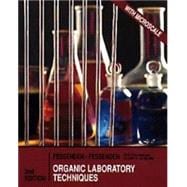
What is included with this book?
| Preface | |
| Introduction to the Organic Laboratory | p. 1 |
| Safety in the Laboratory | p. 1 |
| The Laboratory Notebook | p. 8 |
| Laboratory Equipment | p. 12 |
| Crystallization | p. 23 |
| Solvents for Crystallization | p. 24 |
| Steps in Crystallization | p. 26 |
| Supplemental Procedures | p. 33 |
| Melting Points | p. 39 |
| Characteristics of Melting Points | p. 39 |
| Melting-Point Apparatus | p. 42 |
| Steps in Determining a Melting Point | p. 43 |
| Supplemental Procedures | p. 45 |
| Extraction | p. 49 |
| Immiscible Liquids | p. 50 |
| Distribution Coefficients | p. 51 |
| Extraction Solvents | p. 53 |
| Chemically Active Extraction | p. 54 |
| Steps in Extraction | p. 58 |
| Additional Techniques Used in Extractions | p. 62 |
| Other Extraction Techniques | p. 66 |
| Drying Organic Solutions | p. 71 |
| Extraction with Aqueous Sodium Chloride | p. 71 |
| Solid Inoranic Drying Agents | p. 71 |
| Procedure for Using Solid Inorganic Drying Agents | p. 72 |
| Azeotropic Drying | p. 73 |
| Simple Distillation | p. 77 |
| Characteristics of Distillation | p. 77 |
| Steps in a Simple Distillation | p. 84 |
| Microscale and Semi-Microscale Distillation | p. 88 |
| Fractional Distillation | p. 93 |
| Efficiency of the Fractionation Column | p. 93 |
| Steps in Fractional Distillation | p. 95 |
| Microscale Fractional Distillation | p. 96 |
| Vacuum Distillation | p. 99 |
| Boiling Point and Pressure | p. 99 |
| Apparatus for Simple Vacuum Distillation | p. 100 |
| Steps in Vacuum Distillation | p. 104 |
| Steam Distillation | p. 107 |
| Characteristics of Steam Distillation | p. 107 |
| Amount of Water Needed in a Steam Distillation | p. 108 |
| Apparatus for Steam Distillation | p. 109 |
| Sublimation | p. 111 |
| Atmospheric Sublimation | p. 112 |
| Vacuum Sublimation | p. 113 |
| Refractive Index | p. 115 |
| Correcting for Temperature Differences | p. 116 |
| Steps in Using a Refractometer | p. 117 |
| Column Chromatography | p. 119 |
| Gravity Column Chromatography | p. 120 |
| Flash Chromatography (Macroscale) | p. 126 |
| Flash Chromatography (Microscale) | p. 128 |
| High-Performance Liquid Chromatography (HPLC) | p. 130 |
| Thin-Layer Chromatography | p. 133 |
| The R[subscript f] Value | p. 133 |
| Equipment for TLC | p. 135 |
| Steps in a TLC Analysis | p. 136 |
| A Related Technique: Paper Chromatography | p. 138 |
| Gas Chromatography | p. 141 |
| Gas Chromatography | p. 141 |
| The Gas Chromatography | p. 143 |
| Steps in a GC Analysis | p. 147 |
| Problems Encountered in GC | p. 148 |
| Uses of Gas Chromatograms | p. 149 |
| Carrying Out Typical Reactions | p. 153 |
| Stirring | p. 153 |
| Heating Reaction Mixtures | p. 154 |
| Controlling Exothermic Reactions | p. 156 |
| Adding Reagents to a Reaction Mixture | p. 157 |
| Excluding Moisture from a Reaction Mixture | p. 158 |
| Setting Up a Three-Neck Reaction Flask | p. 159 |
| Hydrogen Halide Gas Traps | p. 161 |
| Infrared Spectroscopy | p. 163 |
| The Infrared Spectrum | p. 163 |
| Absorption of Infrared Radiation | p. 164 |
| Interpreting Infrared Spectra | p. 164 |
| Identifying Types of Compounds | p. 165 |
| Preparing a Sample for an Infrared Spectrum | p. 173 |
| Instrumentation | p. 176 |
| Proton Nuclear Magnetic Resonance Spectroscopy | p. 179 |
| The NMR Spectrum | p. 179 |
| Interpreting NMR Spectra | p. 181 |
| Use of Deuterium in Proton NMR Spectroscopy | p. 191 |
| NMR Spectra of Unknowns | p. 192 |
| The NMR Spectrometer | p. 192 |
| Preparing Samples for NMR Spectra | p. 193 |
| The Chemical Literature | p. 197 |
| Introduction to the Chemical Literature | p. 197 |
| Secondary Literature | p. 198 |
| Primary Literature | p. 201 |
| Commonly Used Calculations | p. 203 |
| Molarity | p. 203 |
| Normality | p. 204 |
| Dilutions | p. 205 |
| Percent Concentrations | p. 205 |
| Percent Yields and Theoretical Yields | p. 206 |
| Elemental Analyses | p. 209 |
| Determining the Empirical Formula | p. 209 |
| Determining the Molecular Formula | p. 210 |
| Interpreting the Results of Elemental Analysis | p. 211 |
| Degree of Unsaturation | p. 211 |
| Health Hazards of Compounds Used in Organic Chemistry | p. 213 |
| Where to Find Chemical Hazard Information | p. 213 |
| Understanding Health Hazard Warnings | p. 216 |
| Table of Contents provided by Syndetics. All Rights Reserved. |
The New copy of this book will include any supplemental materials advertised. Please check the title of the book to determine if it should include any access cards, study guides, lab manuals, CDs, etc.
The Used, Rental and eBook copies of this book are not guaranteed to include any supplemental materials. Typically, only the book itself is included. This is true even if the title states it includes any access cards, study guides, lab manuals, CDs, etc.